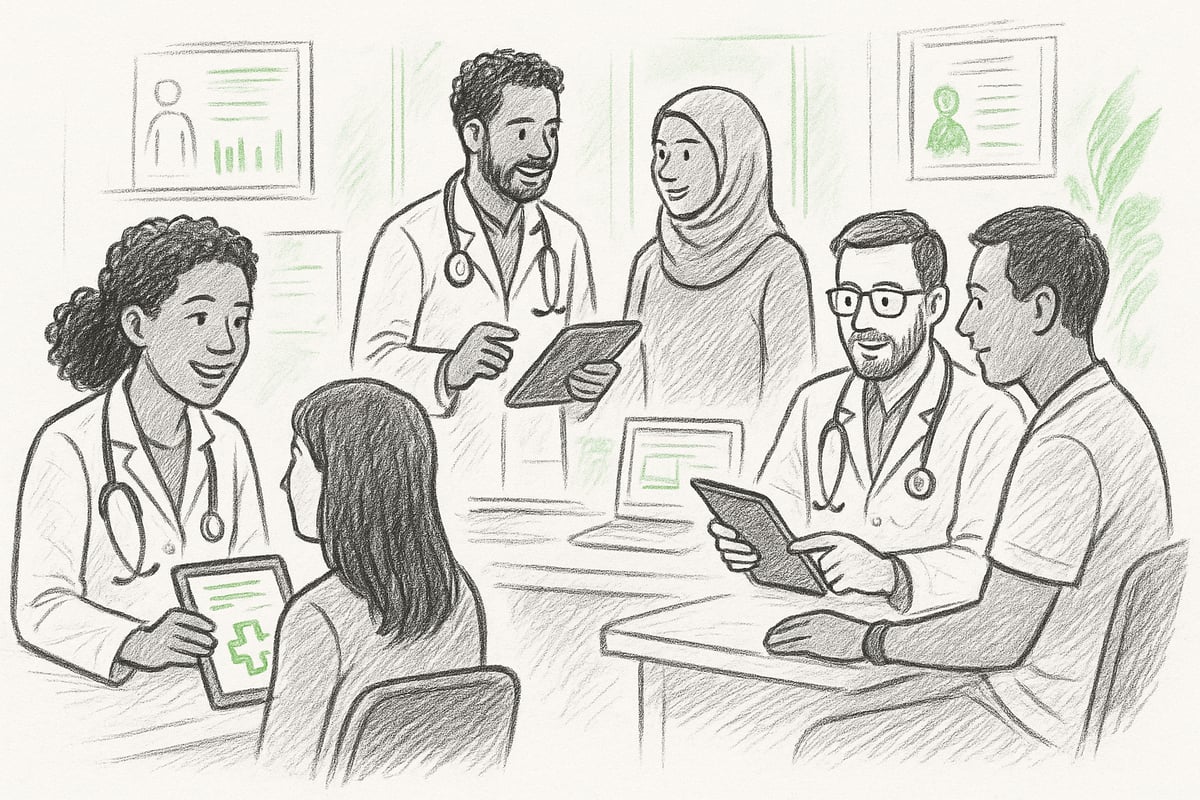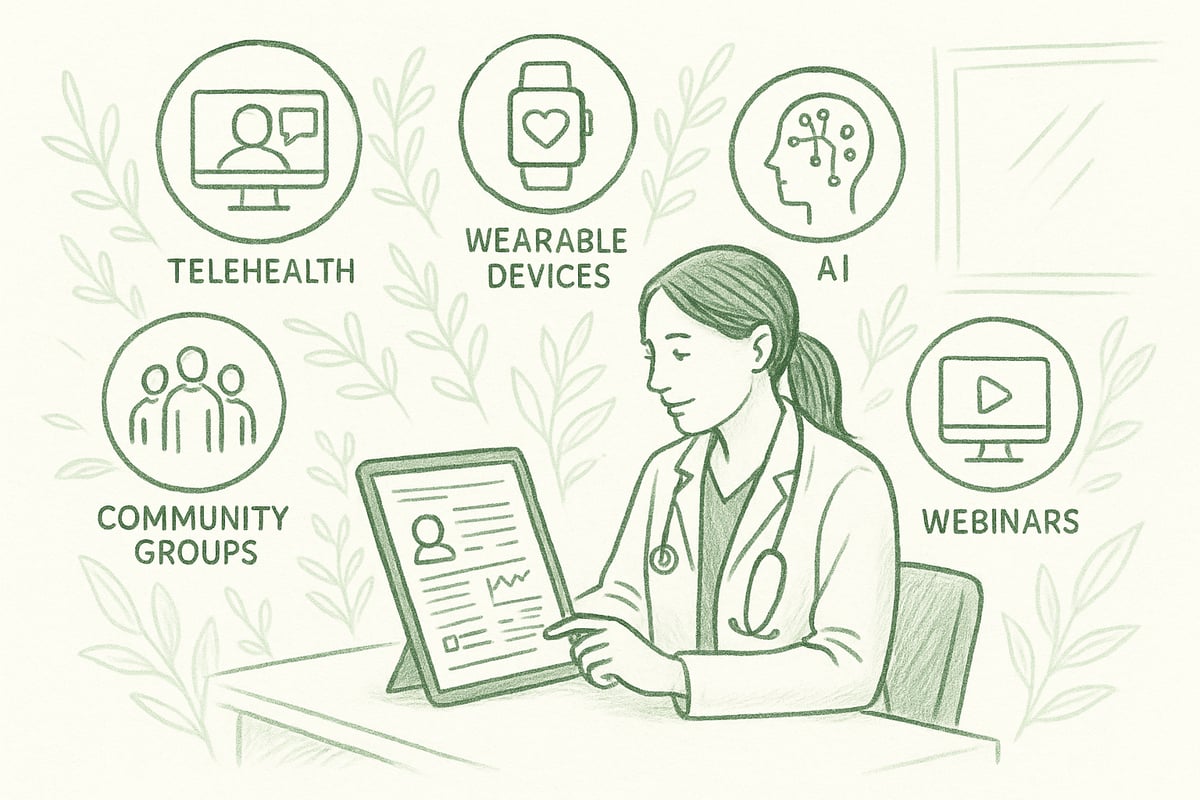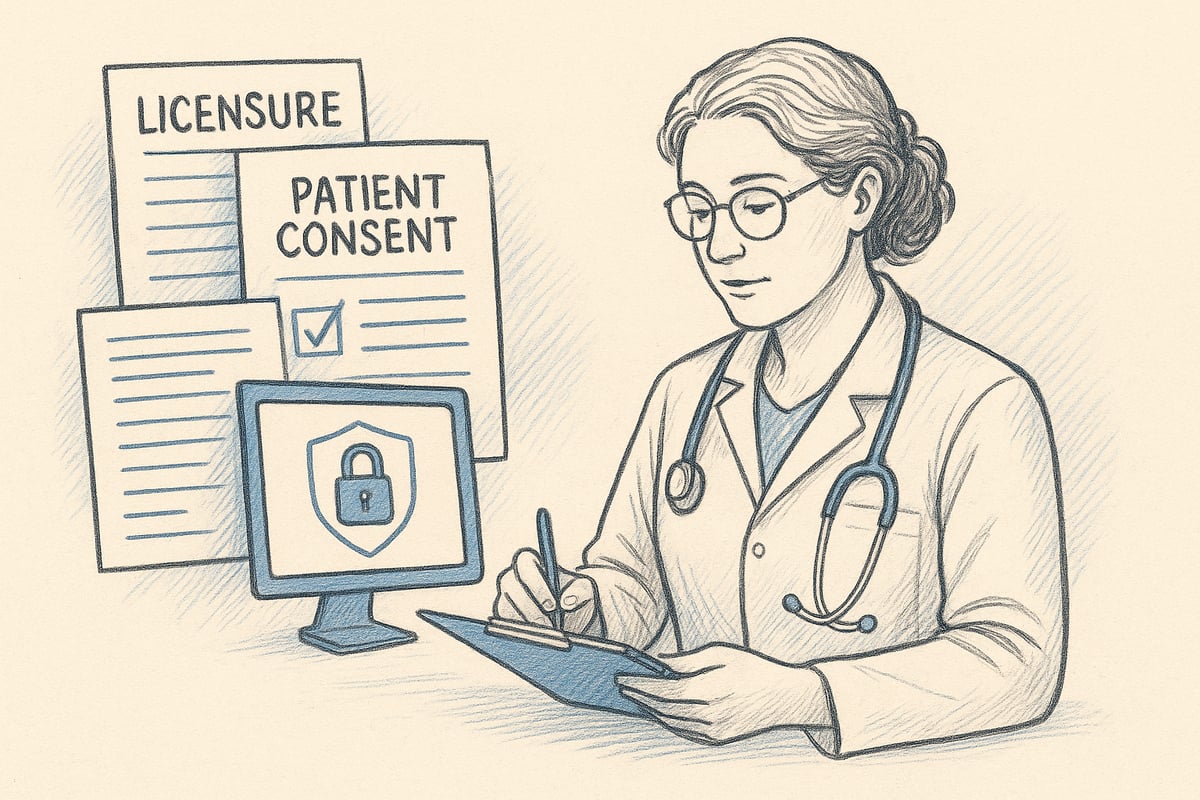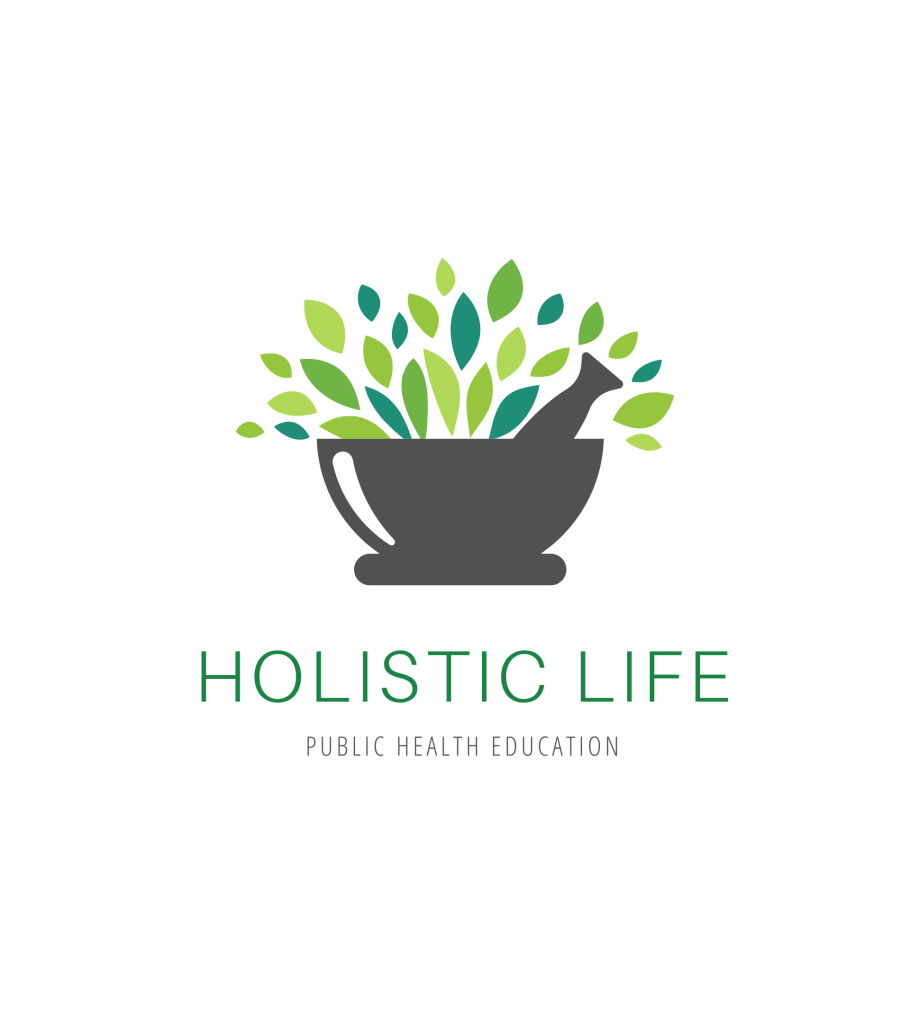2025 marks a turning point as integrative medicine rapidly reshapes global healthcare. The evolving role of the clinical naturopath is now more crucial than ever, with holistic and preventive care in high demand.
This essential guide prepares every clinical naturopath to thrive in a shifting landscape. You will discover the latest clinical protocols, patient-centered approaches, digital innovations, and legal updates.
Ready to master new trends and overcome today’s challenges? Explore evidence-based strategies and practical tools designed to empower practitioners and students alike.
The Evolving Role of the Clinical Naturopath in 2025
The clinical naturopath stands at the forefront of change in 2025. With healthcare rapidly evolving, those in this field must adapt to new expectations, technologies, and opportunities. This section explores the core shifts shaping the clinical naturopath’s daily practice and professional identity.

Shifting Patient Expectations and Demand
Patients today seek holistic, preventive care that addresses underlying causes, not just symptoms. The clinical naturopath responds to this demand by offering personalized, integrative treatment plans.
A 2024 survey revealed that 62 percent of patients now pursue natural therapies alongside conventional medicine. This shift shows a rising trust in naturopathic approaches. Individuals want care tailored to their unique needs, and the clinical naturopath is positioned to deliver exactly that.
- More patients prioritize root-cause resolution
- Demand for individualized wellness plans increases
- Interest in preventive strategies grows each year
This landscape demands adaptability and patient-centered thinking from every clinical naturopath.
Integration with Mainstream Healthcare
Collaboration is becoming the norm for the clinical naturopath. Hospitals and clinics increasingly invite naturopathic consults, especially in chronic disease management. These partnerships foster better outcomes and bridge the gap between conventional and natural care.
For instance, some hospital systems now include clinical naturopath services within multidisciplinary teams treating diabetes or heart disease. This integrated approach ensures patients benefit from both conventional treatments and evidence-based natural therapies.
- Joint care plans with MDs, DOs, and allied health professionals
- Improved communication across disciplines
- Shared decision-making for complex cases
Integration elevates the clinical naturopath’s profile and strengthens the entire healthcare ecosystem.
Expanding Scope of Practice and Specializations
The clinical naturopath’s role is expanding into new areas of specialization. Mental health, metabolic syndrome, and autoimmune disorders are now common focuses. Regulatory changes in several states and provinces have broadened licensure and scope, allowing clinical naturopaths to offer more comprehensive care.
Staying updated on these changes is essential. Specializing in emerging fields opens doors to new patient populations and positions the clinical naturopath as a leader in holistic care.
- New certifications in mental and metabolic health
- Broader diagnostic and therapeutic authority
- Increased opportunities for advanced practice
Adaptability and ongoing education remain critical as the scope of practice evolves.
Emphasis on Evidence-Based Practice
Today’s clinical naturopath must rely on research-backed protocols and standardized guidelines. The adoption of evidence-based approaches, such as standardized herbal extracts and validated lab testing, enhances both safety and effectiveness in patient care.
For students and practitioners, reviewing the AANMC Core Entrustable Professional Activities provides clarity on the core competencies expected in modern naturopathic medicine. Emphasizing evidence builds trust with patients and colleagues alike.
- Use of published clinical guidelines
- Implementation of outcome tracking systems
- Focus on measurable and reproducible results
Evidence-based practice is a cornerstone for every clinical naturopath in 2025.
Diversity, Equity, and Inclusion in Naturopathic Care
The clinical naturopath plays a vital role in addressing health disparities and promoting cultural competence. Community clinics now offer sliding scale fees, making holistic care accessible to underserved populations.
Decolonizing wellness means respecting cultural traditions and integrating them into care plans. Embracing diversity enhances patient outcomes and broadens the impact of naturopathic medicine.
- Multilingual patient resources
- Training in cultural awareness
- Outreach to marginalized communities
A commitment to equity ensures the clinical naturopath serves all individuals effectively.
Technology and Telehealth Integration
Digital transformation is reshaping how the clinical naturopath delivers care. Telehealth adoption has surged, with virtual visits up 38 percent since the pandemic. Remote patient monitoring and digital health records streamline communication and enhance patient engagement.
Wearable devices now provide real-time data, allowing the clinical naturopath to personalize interventions and monitor progress remotely.
- Secure telemedicine platforms
- Integration of health tracking apps
- Online appointment scheduling and follow-up
Embracing technology enables the clinical naturopath to reach more patients and deliver higher-quality care.
Professional Identity and Public Perception
Building trust and credibility is essential for the clinical naturopath in 2025. Clear communication, visible outcomes, and professional branding help shape public perception.
Engaging in community outreach, publishing patient success stories, and participating in policy discussions all strengthen the clinical naturopath’s reputation. As integrative medicine gains recognition, these efforts ensure the profession continues to thrive.
- Active presence in community events
- Transparent patient education
- Collaboration with media and advocacy groups
A strong professional identity supports both individual success and the broader advancement of naturopathic medicine.
Core Clinical Protocols and Therapeutic Approaches
Modern clinical naturopath care is grounded in a hierarchy of therapies, prioritizing the least invasive and most foundational interventions. This section explores the core evidence-based protocols every clinical naturopath should master in 2025, from lifestyle and nutrition to integrative care planning.

The Therapeutic Order: Foundations First
At the heart of every clinical naturopath protocol is the therapeutic order, a stepwise approach that emphasizes starting with the basics—nutrition, lifestyle, and mind-body practices. This order guides practitioners to address obstacles to health before escalating to more invasive interventions.
The clinical naturopath focuses on individualized care, using detailed assessments to tailor foundational recommendations. For example, research shows that lifestyle modification can reduce hypertension rates by up to 40 percent when applied as a first-line intervention.
Participation in events like Naturopathic Medicine Week 2025 underscores the profession’s commitment to patient-centered, evidence-based care.
Nutrition and Functional Medicine Updates
The clinical naturopath stays current with advances in nutrition science, integrating personalized dietary strategies and functional medicine insights. Gut health, metabolic optimization, and the microbiome are at the forefront, with protocols evolving rapidly.
Recent studies highlight the impact of microbiome-targeted interventions for IBS and mood disorders. The clinical naturopath now routinely incorporates lab testing to inform nutrition plans, ensuring recommendations are tailored and measurable. Emphasis is placed on whole foods, anti-inflammatory diets, and nutrient repletion for sustainable outcomes.
Botanical Medicine and Supplementation
Botanical medicine remains central to the clinical naturopath’s toolkit, supported by increasing clinical evidence. Practitioners select standardized herbal extracts and nutraceuticals based on safety, efficacy, and patient-specific factors.
Protocols now include botanicals for immune support, hormone balance, and cognitive health. Safety considerations are paramount, with the clinical naturopath monitoring for interactions and contraindications. For instance, standardized ashwagandha has shown promise in supporting adrenal function and reducing stress, when used judiciously.
Homeopathy and Energetic Therapies
Homeopathy and energetic therapies continue to spark debate within the clinical naturopath community. While research on efficacy is mixed, many practitioners report positive outcomes, especially in pediatric and chronic care settings.
A clinical naturopath may incorporate homeopathy for individualized cases, such as using Chamomilla for pediatric colic. The approach is always patient-centered, with informed consent and transparency about current evidence. Ongoing dialogue within the profession ensures best practices evolve.
Physical Medicine and Manual Therapies
Physical medicine forms a vital part of the clinical naturopath’s practice. Modalities such as bodywork, hydrotherapy, and movement therapies are integrated for musculoskeletal health and chronic pain management.
Studies show that manual therapies, when combined with exercise prescriptions, can improve function and reduce pain in conditions like low back pain. The clinical naturopath develops customized plans, often collaborating with other health professionals for optimal results. Safety, assessment, and progress tracking are emphasized.
Mind-Body and Stress Management Techniques
Mind-body medicine is a cornerstone for the clinical naturopath, especially in stress-related and chronic conditions. Techniques such as mindfulness, breathwork, and biofeedback are routinely incorporated into care plans.
Data indicates that up to 70 percent of naturopathic patients report improved stress resilience after engaging in mind-body protocols. The clinical naturopath teaches these skills, empowering patients to self-regulate and build long-term resilience. Education and follow-up are crucial for sustained benefits.
Integrative Case Management and Care Coordination
Effective case management is essential for the clinical naturopath practicing in a complex healthcare environment. Multidisciplinary care plans, structured referrals, and regular communication with MDs and specialists ensure comprehensive patient support.
A typical example involves coordinating care for complex autoimmune disease, where the clinical naturopath may lead lifestyle interventions while collaborating with conventional providers for medication management. This integrative approach enhances outcomes and patient satisfaction.
Digital Tools and Innovations in Naturopathic Practice
Embracing digital transformation is now essential for every clinical naturopath. The right technological tools can streamline care, improve patient outcomes, and keep practitioners competitive in an evolving landscape. From practice management to AI-driven protocols, digital innovation is reshaping naturopathic medicine.

Essential Practice Management Software
Modern practice management software is foundational for the clinical naturopath. Electronic health records (EHRs), secure messaging, automated scheduling, and billing systems save time and reduce errors. Leading platforms now offer features tailored for naturopathic workflows, including customizable templates and supplement tracking.
| EHR Platform | Key Features | Naturopathic Integration |
|---|---|---|
| Jane | Scheduling, Billing | Yes |
| Charm EHR | Integrative Templates | Yes |
| Practice Better | Nutrition, Supplements | Yes |
Selecting the right tool allows the clinical naturopath to focus more on patient care and less on administration.
Remote Patient Monitoring and Apps
Remote patient monitoring empowers the clinical naturopath to track health metrics in real time. Wearable devices and mobile apps collect data on sleep, activity, heart rate, and blood glucose. This data-driven approach supports early intervention and personalized care.
For example, continuous glucose monitors provide actionable insights for metabolic health management. These tools help the clinical naturopath adjust protocols quickly, enhancing patient engagement and outcomes.
Telehealth Best Practices
Telehealth is now a cornerstone of accessible care. The clinical naturopath must ensure secure, HIPAA-compliant platforms for virtual consults. Effective video visits require clear communication, thorough documentation, and patient-friendly tech support.
A case in point: rural patients can now access specialized care without travel barriers. By adopting telehealth best practices, the clinical naturopath can expand reach and serve diverse communities effectively.
Clinical Decision Support and AI Tools
Artificial intelligence is transforming decision-making for the clinical naturopath. AI tools assist with symptom analysis, risk assessment, and protocol selection, streamlining complex clinical workflows. According to recent data, 45 percent of clinics plan to implement AI-based solutions by 2025.
Emerging systems, such as the AI-Optimized Natural Product Prescription System for Epilepsy, demonstrate how advanced algorithms can personalize therapy and improve safety. Leveraging AI enables the clinical naturopath to deliver more precise, evidence-based care.
Patient Education and Digital Content Delivery
Educating patients is easier than ever through digital platforms. The clinical naturopath can host webinars, develop online courses, and share resources via mobile apps. These tools foster patient empowerment and support ongoing lifestyle changes.
Offering digital content also strengthens the clinical naturopath’s brand, enhancing credibility and patient loyalty.
Community and Peer Support Platforms
Online communities connect patients and professionals, creating spaces for education, encouragement, and shared experiences. The clinical naturopath can moderate forums, participate in peer networks, and facilitate support groups.
Building these virtual communities nurtures trust, drives engagement, and enhances the overall patient journey.
Legal, Regulatory, and Ethical Considerations for 2025
The clinical naturopath profession will face significant legal, regulatory, and ethical shifts in 2025. Staying informed and compliant is essential for protecting your practice, your patients, and your professional reputation.

Licensure and Scope of Practice Updates
In 2025, clinical naturopath licensure continues to evolve across states and provinces. New regulations expand practice rights in emerging regions, while some areas introduce more rigorous educational or clinical requirements.
A recent update from the California Board of Naturopathic Medicine Strategic Plan 2025–2030 outlines anticipated scope changes and professional responsibilities. This strategic plan highlights a growing trend toward integrating clinical naturopath roles into mainstream healthcare, emphasizing the need for practitioners to stay updated on licensure pathways and compliance.
Informed Consent and Patient Autonomy
For the clinical naturopath, informed consent is more than a formality—it is a core aspect of patient-centered care. Best practices include clear documentation, transparent communication, and respect for patient autonomy.
Recent case law emphasizes the importance of ensuring patients fully understand treatment options, risks, and alternatives. By prioritizing patient education and clear consent processes, clinical naturopaths strengthen trust and minimize legal disputes.
Data Privacy and Telehealth Regulations
With the expansion of telehealth, clinical naturopaths must navigate evolving data privacy laws. HIPAA in the US and GDPR in Europe set strict standards for handling patient information.
A 22% rise in data breaches among small practices highlights the urgency for robust cybersecurity measures. Clinical naturopaths should use secure electronic health records, encrypted communication, and regular staff training to maintain compliance and protect sensitive data.
Ethical Dilemmas in Integrative Care
Integrative care presents unique ethical challenges for the clinical naturopath. Navigating conflicts between natural and conventional treatments requires transparency, honesty, and adherence to evidence-based guidelines.
When evidence is limited, managing patient expectations is crucial. Open dialogue, shared decision-making, and clear documentation help clinical naturopaths address ethical dilemmas while maintaining professional integrity.
Professional Liability and Risk Management
Professional liability remains a key concern for the clinical naturopath in 2025. Malpractice trends show increased scrutiny of integrative practices, making risk management strategies essential.
To minimize liability, clinical naturopaths should maintain comprehensive records, pursue ongoing education, and secure appropriate insurance coverage. Regularly reviewing protocols and participating in peer review can further reduce risk and support high-quality patient care.
Building a Thriving Clinical Naturopathic Practice
Success as a clinical naturopath in 2025 depends on mastering diverse practice models, effective marketing, strong patient relationships, financial stability, and continuous growth. Let’s explore strategies to help you excel in a changing healthcare landscape.
Practice Models: Solo, Group, and Integrative Settings
Choosing the right practice setting shapes your day-to-day experience as a clinical naturopath. Each model offers unique strengths and challenges.
| Model | Pros | Cons |
|---|---|---|
| Solo | Autonomy, flexible hours, personal brand | Limited support, higher workload |
| Group | Shared resources, peer collaboration | Less control, profit sharing |
| Integrative | Broader services, MD-ND teamwork | Complex management, regulatory needs |
Integrative clinics are rising, often blending MD and clinical naturopath expertise for comprehensive care. This collaborative approach can enhance patient outcomes, especially in chronic disease management.
Marketing, Branding, and Patient Acquisition
In 2025, digital outreach is essential for every clinical naturopath. With 78% of new patients finding clinics online, a robust web presence is non-negotiable.
Key strategies include:
- Optimizing your website for SEO and local search
- Active social media engagement with educational content
- Encouraging patient testimonials and reviews
A strong brand story, professional imagery, and clear messaging help differentiate your practice. Consistent online activity attracts your ideal patients and builds trust before the first appointment.
Patient Retention and Community Engagement
Building loyalty as a clinical naturopath goes beyond the initial visit. Ongoing education, personalized follow-ups, and community events foster deeper relationships.
Consider hosting monthly wellness workshops or support groups. Clinics report up to 30% higher retention with regular educational offerings. Use newsletters and digital check-ins to keep patients engaged between visits.
Community involvement not only supports retention but also raises your visibility as a trusted health resource.
Financial Management and Revenue Diversification
Financial resilience is crucial for a clinical naturopath. Diversifying income streams helps buffer against market shifts and seasonal trends.
Options include:
- Fee-for-service appointments
- Membership or subscription wellness plans
- Offering online courses or webinars
- Product sales (supplements, health devices)
A hybrid model, combining in-person and virtual care, provides flexibility and broadens your reach. Case studies show this approach can increase patient access and practice revenue.
Professional Development and Continuing Education
Staying current is vital for every clinical naturopath. Invest in certifications, attend conferences, and join peer groups to keep your knowledge sharp.
Pursue top CEU opportunities in areas like integrative protocols, technology in practice, or new therapeutic modalities. Networking with colleagues fosters idea exchange and professional support.
Continuous learning ensures your practice delivers the highest standard of evidence-based care, building both confidence and credibility.
Future Trends and Opportunities in Clinical Naturopathy
The future for the clinical naturopath is bright, with rapid changes shaping both patient care and professional opportunities. By staying informed and adaptable, practitioners can thrive in this evolving landscape.
Advances in Research and Clinical Evidence
Recent years have seen a surge in clinical trials and studies focused on naturopathic therapies. The clinical naturopath now has access to robust evidence supporting botanicals, nutritional protocols, and integrative approaches.
Key research trends include:
- Randomized trials on herbal interventions for anxiety and metabolic health
- Comparative studies of dietary protocols for chronic disease
- Evaluations of mind-body therapies in mental health care
This evidence base empowers the clinical naturopath to deliver care that is both safe and effective.
Personalized and Precision Naturopathic Medicine
Personalized care is becoming the norm. The clinical naturopath integrates genomics, metabolomics, and individualized protocols to address unique patient needs.
| Tool/Approach | Application |
|---|---|
| Genomic testing | Tailored supplement plans |
| Metabolomic panels | Targeted nutrition interventions |
| Microbiome mapping | Gut health optimization |
By leveraging these tools, the clinical naturopath can improve outcomes and patient satisfaction.
Globalization and Cross-Cultural Influences
International collaboration is expanding. Clinical naturopath practitioners now connect with peers worldwide through virtual conferences and cross-border telehealth partnerships.
Examples of global trends:
- Shared case studies at international summits
- Adoption of culturally diverse treatment modalities
- Growth in remote consultations for global patients
This global perspective enriches the clinical naturopath’s practice and broadens the reach of naturopathic care.
Advocacy, Policy, and Public Health Impact
The clinical naturopath is gaining a stronger voice in health policy and preventive care initiatives. Participation in national guideline development and public health campaigns is on the rise.
Recent impacts include:
- Inclusion of naturopathic recommendations in chronic disease policy
- Advocacy for greater insurance coverage of holistic services
- Involvement in community-based wellness programs
These advancements position the clinical naturopath as a key player in shaping healthier societies.
Entrepreneurial and Digital Health Ventures
Innovation is driving new business models. Clinical naturopath professionals are launching digital products, online education platforms, and telehealth services.
Opportunities include:
- Developing mobile health apps for patient engagement
- Offering virtual group programs and webinars
- Expanding into online supplement sales
By embracing digital ventures, practitioners can scale their impact and access new markets.
As you prepare to thrive in the rapidly evolving world of clinical naturopathy, staying informed and empowered is key. This guide has highlighted the strategies, tools, and trends shaping integrative health in 2025—and now, you can take the next step. Whether you’re refining your practice, expanding your knowledge, or seeking practical tools for growth, our in depth resource is designed to support your journey. Download your copy of the Essential Clinical Naturopath Guide and set yourself up for success in the new era of holistic care.
Download Holistic Guide
